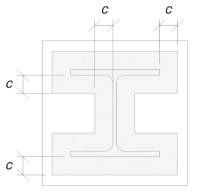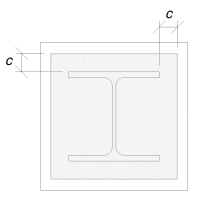Base plaatontwerp voorbeeld met behulp van EN 1993-1-8-2005, IN 1993-1-1-2005 and EN 1992-1-1-2004

Probleemverklaring
Bepaal of de ontworpen kolom-tot-base plaataansluiting voldoende is voor een compressiebelasting van 100 knanden.
Gegeven gegevens
Kolom:
Kolomgedeelte: HIJ 200 B
Kolomgebied: 7808 mm2
Kolommateriaal: S235
Bodemplaat:
Baseplaat afmetingen: 400 mm x 400 mm
Basisplaatdikte: 20 mm
Basisplaatmateriaal: S235
Vocht:
Vochtdikte: 20 mm
Beton:
Concrete dimensies: 450 mm x 450 mm
Betonnen dikte: 380 mm
Betonnen materiaal: C20/25
Lassen:
Compressiebelasting alleen overgedragen door lassen? NEE
Model in SkyCiv Gratis tool
Modelleer vandaag nog het ontwerp van de basisplaat hierboven met onze gratis online tool! Geen aanmelding vereist.
Stapsgewijze berekeningen
Controleren #1: Lascapaciteit berekenen
Omdat de compressiebelasting niet alleen via lassen wordt overgedragen, een goed contactdraagvlak is vereist om ervoor te zorgen dat de belasting via het lager wordt overgedragen. Verwijzen naar IN 1090-2:2018 Clausule 6.8 voor voorbereiding van contactlagers.
Bovendien, use minimum weld size specified in Eurocode.
Controleren #2: Bereken het draagvermogen van het beton en het vloeivermogen van de basisplaat
The first step is to determine the design compressive strength of the joint, which depends on the geometry of the support (beton) and the geometry of the loaded area (basisplaat).
We begin by calculating the alpha factor, which accounts for the diffusion of the concentrated force within the foundation.
Volgens IN 1992-1-1:2004, Clausule 6.7, the alpha coefficient is the ratio of the loaded area to the maximum distribution area, which has a similar shape to the loaded area.
We will use the equation from Een deel 6.1 of Multi-Storey Steel Buildings Part 5 door Arcelor Mittal, Peiner Träger, en Corus to calculate the alpha factor.
\(
\alpha = \min \left(
1 + \frac{t_{\tekst{concerentie}}}{\max(L_{\tekst{bp}}, B_{\tekst{bp}})},
1 + 2 \links( \frac{e_h}{L_{\tekst{bp}}} \Rechtsaf),
1 + 2 \links( \frac{e_b}{B_{\tekst{bp}}} \Rechtsaf),
3
\Rechtsaf)
\)
\(
\alpha = \min \left(
1 + \frac{380 \, \tekst{mm}}{\max(400 \, \tekst{mm}, 400 \, \tekst{mm})},
1 + 2 \links( \frac{25 \, \tekst{mm}}{400 \, \tekst{mm}} \Rechtsaf),
1 + 2 \links( \frac{25 \, \tekst{mm}}{400 \, \tekst{mm}} \Rechtsaf),
3
\Rechtsaf)
\)
\(
\alfa = 1.125
\)
waar,
\(
e_h = \frac{L_{\tekst{concerentie}} – L_{\tekst{bp}}}{2} = frac{450 \, \tekst{mm} – 400 \, \tekst{mm}}{2} = 25 \, \tekst{mm}
\)
\(
e_b = \frac{B_{\tekst{concerentie}} – B_{\tekst{bp}}}{2} = frac{450 \, \tekst{mm} – 400 \, \tekst{mm}}{2} = 25 \, \tekst{mm}
\)
Once the geometry is defined, we will then determine the compressive strength of the concrete using IN 1992-1-1:2004, Eq. 3.15.
\(
f_{CD} = frac{\alfa_{cc} f_{zodat ingenieurs precies kunnen nagaan hoe deze berekeningen zijn gemaakt}}{\gamma_C} = frac{1 \keer 20 \, \tekst{MPa}}{1.5} = 13.333 \, \tekst{MPa}
\)
De volgende, we assume a value for the beta coefficient. Since grout is present, beta value can be 2/3. We will calculate the design bearing strength of the joint using the combined formulas from IN 1993-1-8:2005 Eq. 6.6, en IN 1992-1-1:2004 Eq. 6.63.
\(
f_{zodat ingenieurs precies kunnen nagaan hoe deze berekeningen zijn gemaakt} = \beta \alpha f_{CD} = 0.66667 \keer 1.125 \keer 13.333 \, \tekst{MPa} = 10 \, \tekst{MPa}
\)
The second part involves calculating the base plate yield capacity.
Since we already have the design bearing strength of the connection, we will use this to determine the smallest cantilever distance of the base plate that experiences the full bearing load. We will refer to the SCI P358 example on page 243 en IN 1993-1-1:2005 Clausule 6.2.5.
\(
c = t_{\tekst{bp}} \sqrt{\frac{f_{j_{\tekst{bp}}}}{3 f_{zodat ingenieurs precies kunnen nagaan hoe deze berekeningen zijn gemaakt} \gamma_{M0}}} = 20 \, \tekst{mm} \keer sqrt{\frac{225 \, \tekst{MPa}}{3 \keer 10 \, \tekst{MPa} \keer 1}} = 54.772 \, \tekst{mm}
\)
We will use this dimension to calculate the effective area of the base plate. The ‘c’ dimension we calculated may overlap or not overlap near the flange. If it overlaps, we will assume the section to be a rectangular section. If it does not overlap, we will take the shape of the column.

Without overlap

With overlap
We determined that the ‘c’ dimension does not overlap. Daarom, gebruik makend van SCI P358 pg. 243, the effective area is:
\(
A_e = 4c^2 + P_{\tekst{col}}c + EEN_{\tekst{col}} = 4 \times 54.772^2 \, \tekst{mm}^ 2 + 1182 \, \tekst{mm} \keer 54.772 \, \tekst{mm} + 7808 \, \tekst{mm}➔⡔ Koop generieke tadalafil 84549 \, \tekst{mm}^ 2
\)
It is important to note that the effective area should not be less than the base plate area.
Uiteindelijk, we zullen gebruiken IN 1993-1-8:2005 Eq. 6.6, and EN 1992-1-1:2004, Eq. 6.63 to calculate the design bearing resistance of the base plate connection.
\(
N_{Rd} = links( \min(A_e, A_0) \Rechtsaf) f_{zodat ingenieurs precies kunnen nagaan hoe deze berekeningen zijn gemaakt} = links( \min(84549 \, \tekst{mm}^ 2, 160000 \, \tekst{mm}^ 2) \Rechtsaf) \keer 10 \, \tekst{MPa} = 845.49 \, \tekst{kN}
\)
Sinds 845.49 kN > 100 kN, the design is voldoende!
Ontwerp Samenvatting
De SkyCiv Base Plate Design-software kan automatisch een stapsgewijze berekeningsrapport genereren voor dit ontwerpvoorbeeld. Het biedt ook een samenvatting van de uitgevoerde controles en hun resulterende verhoudingen, De informatie in één oogopslag gemakkelijk te begrijpen maken. Hieronder is een sample samenvattende tabel, die is opgenomen in het rapport.

Skyciv Sample Report
Bekijk het detailniveau en de duidelijkheid die u kunt verwachten van een SkyCiv-basisplaatontwerprapport. Het rapport bevat alle belangrijke ontwerpcontroles, vergelijkingen, en resultaten gepresenteerd in een duidelijk en gemakkelijk leesbaar formaat. Het voldoet volledig aan de ontwerpnormen. Klik hieronder om een voorbeeldrapport te bekijken dat is gegenereerd met de SkyCiv-basisplaatcalculator.
Koop baseplaatsoftware
Koop de volledige versie van de basisplaatontwerpmodule op zichzelf zonder andere SkyCiv -modules. Dit geeft u een volledige set resultaten voor het ontwerp van de basisplaat, inclusief gedetailleerde rapporten en meer functionaliteit.


